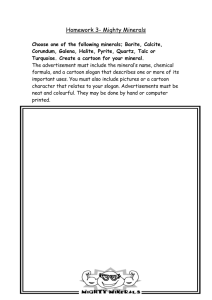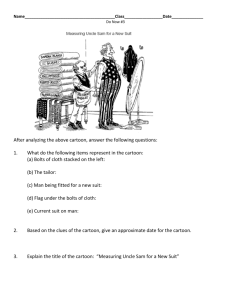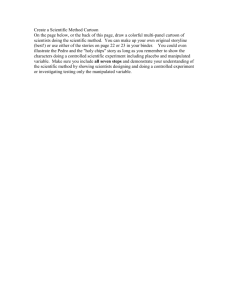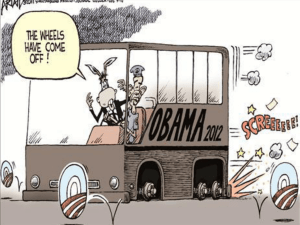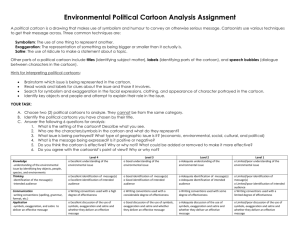gather evidence for writing prompt - UC Berkeley History
advertisement
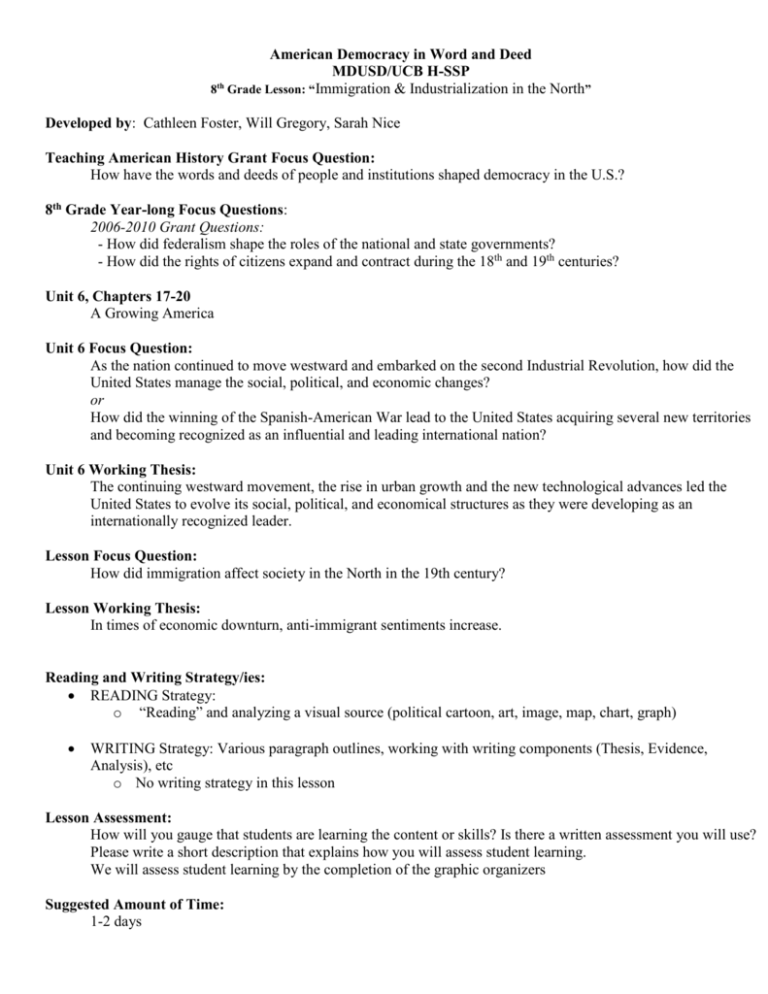
American Democracy in Word and Deed MDUSD/UCB H-SSP 8th Grade Lesson: “Immigration & Industrialization in the North” Developed by: Cathleen Foster, Will Gregory, Sarah Nice Teaching American History Grant Focus Question: How have the words and deeds of people and institutions shaped democracy in the U.S.? 8th Grade Year-long Focus Questions: 2006-2010 Grant Questions: - How did federalism shape the roles of the national and state governments? - How did the rights of citizens expand and contract during the 18th and 19th centuries? Unit 6, Chapters 17-20 A Growing America Unit 6 Focus Question: As the nation continued to move westward and embarked on the second Industrial Revolution, how did the United States manage the social, political, and economic changes? or How did the winning of the Spanish-American War lead to the United States acquiring several new territories and becoming recognized as an influential and leading international nation? Unit 6 Working Thesis: The continuing westward movement, the rise in urban growth and the new technological advances led the United States to evolve its social, political, and economical structures as they were developing as an internationally recognized leader. Lesson Focus Question: How did immigration affect society in the North in the 19th century? Lesson Working Thesis: In times of economic downturn, anti-immigrant sentiments increase. Reading and Writing Strategy/ies: READING Strategy: o “Reading” and analyzing a visual source (political cartoon, art, image, map, chart, graph) WRITING Strategy: Various paragraph outlines, working with writing components (Thesis, Evidence, Analysis), etc o No writing strategy in this lesson Lesson Assessment: How will you gauge that students are learning the content or skills? Is there a written assessment you will use? Please write a short description that explains how you will assess student learning. We will assess student learning by the completion of the graphic organizers Suggested Amount of Time: 1-2 days Textbook: Deverell, William and White, Deborah Gray. United States History: Independence to 1914. Orlando, Florida: Holt, Rinehart and Winston., 2006, Chapter 18: “An Industrial Nation,” pp588Primary Source Citation: “American Platform of Principles,” The True American’s Almanac and Politician’s Manual for 1857. ed. Tisdale. New York, 1857. Political Cartoon for the Know Nothing Party, 1854. Source: Private collection, Peter Newark American Pictures, Bridgeman Art Library Emigration: The Anti-Chinese wall. The American wall goes up as the Chinese original goes down. Cartoon, 1882. Source: Puck Magazine Context of the lesson in the unit (and its connection to American Democracy in Word and Deed): This lesson is designed to either be incorporated in chapter 13 or 18 or both. OR…this could go with a thematic unit on immigration Lesson Procedure: 1. Present students with the unit focus question: How did economic downturns affect attitudes towards immigration in the 19th Century? Pass out the Real GDP Per Capita worksheet. Have students circle GDP in the title and write down that this means “gross domestic product”. If students have not let learned what GDP is, explain to them that GDP helps people understand the health of the economy. It is the total dollar value of all goods and services produced by a country. When it is higher, the economy is doing well; when it is lower, the economy is not doing well. 2. Ask a student to read “What is Real GDP Per Capita?” and the corresponding answer at the top of the worksheet. You may want to further explain this concept depending on your students. For example, you might want to say: “Real GDP Per Capita takes a country’s GDP and divides it equally amongst the number of people in a country.” 3. Tell students that they will be graphing GDP Per Capita to see where the economy started doing poorly. Demonstrate how to graph the data for 1855. Allow students to work on their own and finish graphing the data. 4. Students can then work in groups to answer the questions. Review the answers to the questions. By question #5 students are hypothesizing how a bad economy will afffect attitudes towards immigration. Discuss these answers and tell them that they will be looking at a primary source written by a party that is against immigration. 5. Read primary source expert 6. Model with students how they should complete the Analyzing a Primary Source Worksheet. Fill out the who and when/where as a class. Read the source as a class. For each excerpt, paraphrase what it means (you may have students volunteer to do this) and complete the rest of the chart. 7. Pass out a copy of the political cartoons to each student. You may also want to project a larger copy onto a screen, if possible. Complete the How to Analyze a Political Cartoon worksheet as a class. Fill out the title/author/context information as a class. Have students point out different parts of the cartoon and tell you what they think it represents. Complete the chart together. 8. Repeat the process in step #7 for the second cartoon. Even if your class has not yet reached the Chinese Exclusion Act, this is a great preview of what is to come in the future. You may want to start by asking the class what “exclude” means, or what it means when you are told that you are excluding people. From this, students will be able to hypothesize what happens with the Chinese Exclusion Act. Complete the chart and review what the message/main argument of the cartoon is. 9. At your discretion, discuss real per capita GDP year sets to link/connect to the current economic environment. This information is attached as “Optional Materials” History-Social Science Content Standards: 8.6.3 List the reasons for the wave of immigration from Northern Europe to the United States and describe the growth in the number, size, and spatial arrangements of cities (e.g., Irish immigrants and the Great Irish Famine). 8.12.7 Identify the new sources of large-scale immigration and the contributions of immigrants to the building of cities and the economy; explain the ways in which new social and economic patterns encouraged assimilation of newcomers into the mainstream amidst growing cultural diversity; and discuss the new wave of nativism. Historical and Social Sciences Analysis Skills: Students understand and distinguish cause, effect, sequence, and correlation in historical events, including the longand short-term causal relations. Students interpret basic indicators of economic performance and conduct cost-benefit analyses of economic and political issues. Common Core Standards Reading standards for Literacy in History/Social Studies Grades 6-8 Key Ideas and Details 1. Cite specific textual evidence to support analysis of primary and secondary sources. Craft and Structure 6. Identify aspects of a text that reveal an author’s point of view or purpose (e.g. loaded language, inclusion or avoidance of particular facts) Integration of Knowledge and Idea 7. Integrate visual information (e.g., in charts, graphs, photographs, videos, or maps) with other information in print and digital texts. Name:________________________ Real GDP Per Capita What is Real GDP Per Capita? Real GDP Per Capita is each person’s share of the national income adjusted for inflation. 1. Graph the data from the table below onto the chart. Year GDP Per Capita 1855 $2,512.80 1856 $2,543.06 1857 $2,486.22 1858 $2,520.57 1859 $2,640.56 1860 $2,605.51 2. In which year(s) did the GDP Per Capita drop? 3. Using the first decline/drop, what was the difference (in dollars) from the previous year? 4. How many years did it take to reach the GDP Per Capita level it was at before the decline? 5. How might the economy affect attitudes towards immigration? Teacher Key Real GDP Per Capita What is Real GDP Per Capita? Read GDP Per Capita is each person’s share of the national income adjusted for inflation. 1. Graph the data from the table below onto the chart. Year GDP Per Capita 1855 $2,512.80 1856 $2,543.06 1857 $2,486.22 1858 $2,520.57 1859 $2,640.56 1860 $2,605.51 Teacher Key 2. In which year(s) did the GDP Per Capita drop? It dropped in 1857 and 1860 3. Using the first decline/drop, what was the difference (in dollars) from the previous year? It dropped $56.84 4. How many years did it take to reach the GDP Per Capita level it was at before the decline? It took two years (until 1859) 5. How might the economy affect attitudes towards immigration? When the economy is declining there are negative feelings toward immigrants. Ex: The rise of the KnowNothing Party. Primary Source Excerpt: The True American’s Almanac: Platform of Principles American Platform of Principles Adopted at Philadelphia, Thursday, February 21, 1856. 3. Americans must rule America, and to this end native-born citizens should be selected for all State, Federal, and municipal1 offices of government employment, in preference to all other… 5. No persons should be selected for political station (whether of native or foreign birth), who recognizes any allegiance or obligation of any description to any foreign prince, potentate2 or power, or who refuses to recognize the Federal and State Constitution (each within its sphere) as paramount to all other laws, as rules of political action… 9. A change in the laws of naturalization3, making a continued residence of twenty-one years, of all not heretofore provided for, an indispensable requisite4 for citizenship hereafter, and excluding all paupers5, and persons convicted of crime from landing upon our shores; but no interference with the vested rights of foreigners. “American Platform of Principles,” The True American’s Almanac and Politician’s Manual for 1857. ed. Tisdale. New York, 1857. 1 city Person of great power or authority 3 The process for becoming a citizen 4 Mandatory requirement 5 A very poor person 2 Name:______________________ ANALYZING A PRIMARY SOURCE -- STUDENT VERSION Focus Question: How did economic downturns affect attitudes towards immigration in the 19th Century? Title of Source: _____________________________________ Author: ____________________ Genre (letter, cartoon, photo?): _________________ WHO Author: Background, sex, race, social class, education; What is his/her perspective? WHEN & WHERE Place and Time: Where and When was it published? Historical Context: What was going on during this event or era/period? Audience: Who is the intended audience? OBSERVATIONS DESCRIPTION OF SOURCE Evidence of.. Specific Quotes MEANING What the objects, words, etc. mean MESSAGE/ARGUMENT The author is trying to tell me… IDENTIFYING THE MAIN IDEA Looking at your observations of the primary source, what is the main idea or message of the source? QUESTIONS I wonder… My reaction to the source is… Name________________ P.________ Date____________ ANALYZING A PRIMARY SOURCE -- TEACHER KEY Focus Question: How did economic downturns affect attitudes towards immigration in the 19th Century? Title of Source: American Platform of Principles Author: Members of the nativist American Party Genre (letter, cartoon, photo?): political party platform WHO Author: Members of the nativist political party known as the American Party, Native American Party or the “KnowNothing” Party Audience: Members of the American Party, other nativists, prospective voters, the American public, etc. WHEN & WHERE Place and Time: Philadelphia, Pennsylvania. February 21, 1856 Historical Context: Westward Expansion, Large-scale German and Irish Immigration, Industrial Revolution, economic downturn, anti-immigrant sentiment, lead up to Civil War OBSERVATIONS DESCRIPTION OF SOURCE Evidence of.. Specific Quotes MEANING What the objects, words, etc. mean MESSAGE/ARGUMENT The author is trying to tell me… “Americans must rule America” “native-born citizens should be selected for all State, Federal, and municipal offices” Only people born in America should rule and hold power Immigrants should not have a say “No persons should be selected… who recognizes any allegiance… to any foreign prince, potentate or power…” You can’t be selected and be You must be loyal only to the loyal to a foreign ruler or U.S., not another country or power power (e.g. the Pope) – AntiCatholic You have to live in the U.S. for 21 years to become a They are not fans of the Irish citizen and you can’t be (paupers), and it will be really poor or a convict tough to become a citizen QUESTIONS I wonder… My reaction to the source is… Reminds me of Arizona law on illegal immigration Worries about JFK as president, or even Mitt Romney “making a continued residence of twenty-one years… an indispensable requisite for citizenship… and excluding 21 years is 8 years all paupers, and persons convicted of crime from landing beyond the average upon our shores.” 8th graders life! IDENTIFYING THE MAIN IDEA Looking at your observations of the primary source, what is the main idea or message of the source? I think that the American Party was trying to show their anti-immigrant stance in their party platform from 1856 by making it more difficult for immigrants to hold political power and become citizens. Political Cartoon Analysis Political Cartoon for the Know Nothing Party, 1854. Source: Private collection, Peter Newark American Pictures, Bridgeman Art Library Original caption: Emigration: The Anti-Chinese wall. The American wall goes up as the Chinese original goes down. Cartoon, 1882. Source: Puck Magazine NAME: ______________________________ ANALYZING A POLITICAL CARTOON FOCUS QUESTION: How did economic downturns affect attitudes towards immigration in the 19th Century? BACKGROUND INFORMATION TITLE OF CARTOON: _____________________________________ AUTHOR/PUBLISHER: __________________________ PLACE AND TIME: Where and when was it published? Background information of the publication. _____________________________________________________________________________________________________ _____________________________________________________________________________________________________ HISTORICAL CONTEXT: What was going on during this event or era/period? ____________________________________________________________________________________________________ ____________________________________________________________________________________________________ OBSERVATIONS DESCRIPTION OF THE CARTOON What I see… What objects, symbols, captions, people are portrayed in the cartoon? Be specific! MEANING What do the objects, people, words, etc. symbolize or represent? QUESTIONS/REACTION I wonder… My reaction to the cartoon is… Symbolism Exaggeration Captions/ Labels Analogy Irony Symbolism Exaggeration Captions/ Labels Analogy Irony Symbolism Exaggeration Captions/ Labels Analogy Irony Symbolism Exaggeration Captions/ Labels Analogy Irony MESSAGE/ARGUMENT: What is the cartoonists’ point of view about this topic or issue? Teacher Key NAME: ______________________________ ANALYZING A POLITICAL CARTOON FOCUS QUESTION: How did economic downturns affect attitudes towards immigration in the 19th Century? BACKGROUND INFORMATION TITLE OF CARTOON: Political Cartoon for the Know Nothing Party, 1854. AUTHOR/PUBLISHER: Private collection, Peter Newark American Pictures, Bridgeman Art Library PLACE AND TIME: Where and when was it published? Background information of the publication. America, 1854 HISTORICAL CONTEXT: What was going on during this event or era/period? Know Nothing Party established 1849. They have growing political power. There is nativist sentiment. Economic decline in 1857. OBSERVATIONS DESCRIPTION OF THE CARTOON What I see… What objects, symbols, captions, people are portrayed in the cartoon? Be specific! X Symbolism A man wearing a barrel that says “Irish Exaggeration Whiskey”. He is wearing stereotypically Irish Captions/ Labels Analogy clothing – leprechaun hat and shoes. Irony Another man wearing a barrel that says “Lager Bier”. He looks stereotypically German – beard and lederhosen. X Symbolism Exaggeration Captions/ Labels Analogy Irony MEANING What do the objects, people, words, etc. symbolize or represent? The Irish are stereotypically presented as alcoholics. As immigrants, they were discriminated against because of their religious differences. The German are stereotypically always drinking beer. Two men stealing a ballot box. Symbolism Exaggeration Captions/ Labels Analogy Irony The men have dressed up in costume in order to steal the ballot box (and thus influence the results of the election). A rioting crowd in the background. Symbolism Exaggeration Captions/ Labels Analogy Irony The Irish and German either cause or take advantage of chaos to steal the election. QUESTIONS/REACTION I wonder… My reaction to the cartoon is… Answers will vary. May include: Why are the people rioting in the background? Why would the Irish and German want to steal an election? MESSAGE/ARGUMENT: What is the cartoonists’ point of view about this topic or issue? The cartoonist thinks that the Irish and German are conspiring together to steal elections. NAME: ______________________________ ANALYZING A POLITICAL CARTOON FOCUS QUESTION: How did economic downturns affect attitudes towards immigration in the 19th Century? BACKGROUND INFORMATION TITLE OF CARTOON:________________________________ AUTHOR/PUBLISHER: _______________________________________ PLACE AND TIME: Where and when was it published? Background information of the publication. ________________________ HISTORICAL CONTEXT: What was going on during this event or era/period? __________________________________________ OBSERVATIONS DESCRIPTION OF THE CARTOON What I see… What objects, symbols, captions, people are portrayed in the cartoon? Be specific! MEANING What do the objects, people, words, etc. symbolize or represent? QUESTIONS/REACTION I wonder… My reaction to the cartoon is… Symbolism Exaggeration Captions/ Labels Analogy Irony Symbolism Exaggeration Captions/ Labels Analogy Irony Symbolism Exaggeration Captions/ Labels Analogy Irony Symbolism Exaggeration Captions/ Labels Analogy Irony MESSAGE/ARGUMENT: What is the cartoonists’ point of view about this topic or issue? Teacher Key NAME: ______________________________ ANALYZING A POLITICAL CARTOON FOCUS QUESTION: How did economic downturns affect attitudes towards immigration in the 19th Century? BACKGROUND INFORMATION TITLE OF CARTOON: Emigration: The Anti-Chinese wall. The American wall goes up as the Chinese original goes down. AUTHOR/PUBLISHER: Puck Magazine PLACE AND TIME: Where and when was it published? Background information of the publication. 1882 HISTORICAL CONTEXT: What was going on during this event or era/period? The Chinese Exclusion Act was passed in 1882, after an earlier attempt was vetoed by President Hayes in 1879. OBSERVATIONS DESCRIPTION OF THE CARTOON What I see… What objects, symbols, captions, people are portrayed in the cartoon? Be specific! Symbolism A line of men bringing bricks to build a wall. X Exaggeration Then men are all caricatures – Irish, African Captions/ Labels Analogy American, Jewish, and others are represented. X Irony MEANING What do the objects, people, words, etc. symbolize or represent? Former groups of immigrants (who have been discriminated against) have become Americanized and are now working together to exclude the Chinese. These are the reasons why people discriminated against immigrants. The Chinese are just the latest group. The bricks have different words on them – Fear, Non-Reciprocity, Un-American, Law Against Race, Jealousy, Competition, etc. Symbolism Exaggeration X Captions/ Labels Analogy X Irony An older man with a beard putting down the mortar to assemble the wall. X Symbolism Exaggeration Captions/ Labels Analogy Irony The man represents “Uncle Sam” or the United States. In the background, men are disassembling the Great Wall of China and boats are coming through. Symbolism Exaggeration Captions/ Labels Analogy X Irony After years of isolating themselves from the rest of the world, the Chinese now want to emigrate to the U.S. QUESTIONS/REACTION I wonder… My reaction to the cartoon is… Answers will vary. May include: What was happening in China to make them want to emigrate? Why did people who had been discriminated against work to discriminate against newer immigrants? MESSAGE/ARGUMENT: What is the cartoonists’ point of view about this topic or issue? The cartoonist thinks it’s ironic for members of previous waves of immigration to work together to exclude the Chinese. Optional Materials Real Per Capita GDP (2005 Dollars) Year Sets: 1835-1840- Panic of 1837 1855-1860- Know Nothing Party (founded 1849, Political success in 1850s) 1870-1877- Panic of 1873 1878-1883- Panic of 1879 and Chinese Exclusion Act (attempted to pass in 1878-vetoed by Hayes, passed in 1882) 2005-2009- Present Day Comparisons Year Real Per Capita GDP 1835 $1,895.18 1836 $1,897.46 1837 $1,860.29 1838 $1,885.41 1839 $1,883.69 1840 $1,837.66 Year Real Per Capita GDP 1855 $2,512.80 1856 $2,543.06 1857 $2,486.22 1858 $2,520.57 1859 $2,640.56 1860 $2,605.51 Year Real Per Capita GDP 1870 $2,813.59 1871 $2,868.02 1872 $3,030.00 1873 $3,200.30 1874 $3,170.20 1875 $3,090.61 1876 $3,151.56 1877 $3,242.69 Year Real Per Capita GDP 1878 $3,283.23 1879 $3,595.59 1880 $3,816.27 1881 $4,193.03 1882 $4,296.41 1883 $4,290.16 1884 $4,114.30 1885 $4,034.45 1886 $4,277.96 Year Real Per Capita GDP 2005 $42,697.30 2006 $43,424.80 2007 $43,842.49 2008 $43,440.06 2009 $41,890.45


